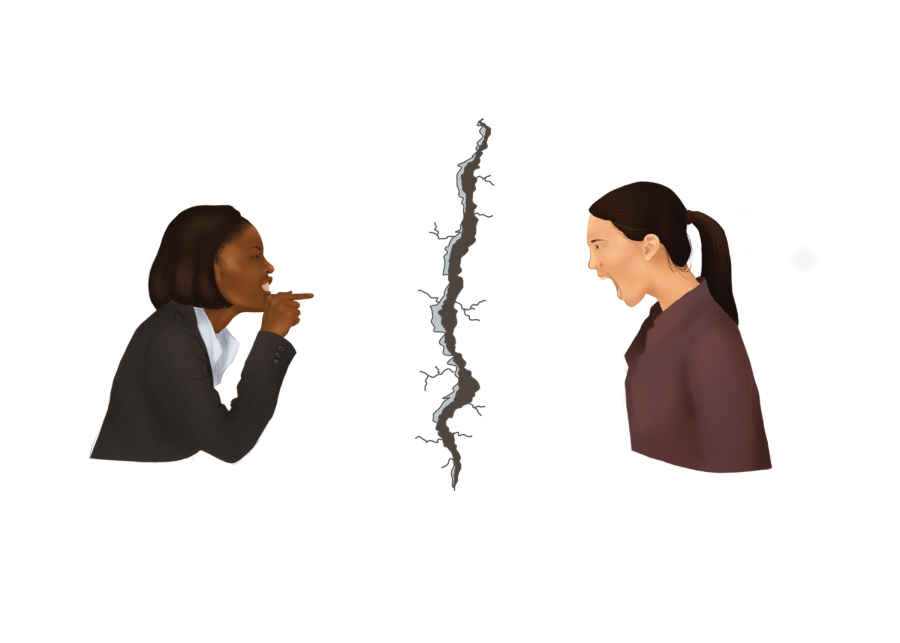Friend or foe?
An interminority relationship complicated by misconceptions
A Black Lives Matter sign was vandalized in the Ventura neighborhood of Palo Alto on April 5 by someone who replaced the word “Black” with “Asian” by taping an adhesive over the original sign. Cops have deemed it a hate crime. But oddly enough, I wasn’t shocked when I heard the news.
“An Asian being racist to Black people—what’s new?” I thought.
Though there have been many high-profile instances of racist exchanges between Asian Americans and Black Americans in America, that doesn’t justify this subconscious thought.
Without having realized it, I’ve acknowledged the history of anti-Blackness within Asian communities and I’ve accepted it without a second thought, only to realize that I’ve never stopped to ask the big question: Why?
Why are minorities fighting other minorities? Shouldn’t they find solidarity with each other and fight for equality together?
Sociologists have coined this phenomenon as horizontal hostility: “when people from targeted groups believe, act on, or enforce dominant systems of oppression against other members of targeted groups,” according to Maryville University. V.S. Patel, an activist with a minor in Asian American studies, uses the conflicts between Black and Korean people caused by the 1992 Los Angeles riots as an example, but this phenomenon can be widely applied to more general minority groups too.
As a result, the power of racial minorities is diluted. According to Dr. Anthony C. Ocampo, an associate professor of sociology at Cal Poly Pomona, “[Racist systems are] meant to relegate us to the margins, to keep us in subordinate positions, to keep us out of leadership positions, to basically be in a position where we can’t write our own stories in this country.
One example of a stereotype that perpetuates horizontal hostility is the good ol’ model minority myth.
People, especially white people, have used the success of Asian Americans (more often East-Asian Americans considering Asian Americans have the largest income gap, according to a 2018 research study by Pew Research Center of all racial groups) as a racial wedge between Asian Americans and African Americans.
According to a study in the Journal of Association of American Medical Colleges, “the model minority myth continues to pit minority groups against each other by reinforcing the existing racial hierarchy while disregarding the complex and multifaceted history of oppression that AAPIs have faced.”
Another example of horizontal hostility is the how, according to the study “Hate Crimes against Asian Americans” published in the American Journal of Criminal Justice, an examination of hate crime data from 1992 to 2014 found that compared to anti-Black and anti-Latino hate crimes, a higher proportion of perpetrators of anti-Asian hate crimes were people of color.
Unfortunately, as an Asian American, I can attest to the anti-Black sentiment within Asian cultures. When I’ve visited China, I’ve picked up on racism against Black people, whether it be subtle aggressions or blatant bigotry.
I notice changes in language and behavior around when Black people are mentioned versus white people. For example, people talk about Black people with a sense of superiority while they speak only with admiration for white people. Additionally, colorism is rampant within the Asian American community: “Whitening” lotions and face masks can be found in most beauty shops. A common way to “compliment” someone is to comment on how beautiful their “pale and fair skin” is. Likewise, an “unattractive” feature is being too tan.
Though I cannot claim that my encounters with racism in China mean all Asians have anti-Black sentiment, I can point out a pattern that I’ve seen not only in my experiences but also in the experiences of my Asian friends.
At the end of the day, I believe we have to understand that we as minorities are all fighting for the same things.
Like Lính Thủy Nguyễn, assistant professor of American Ethnic Studies at the University of Washington, said, the model minority myth (an example of horizontal hostility among different racial minorities) “makes it difficult to see the damage, not only to other racialized communities, but also to our own families and communities.”
It isn’t helpful for minorities to fight each other. Instead, we should fight alongside each other.
